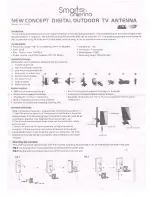
6
Functional description
Description of operation
After power-up, the antenna performs a self-test and calibration lasting up to five
minutes. It then enters search mode and starts searching for a satellite. The antenna
automatically calculates the elevation of the selected satellite using a built-in GPS-
receiver to determine the current position
1
.
After locking on a satellite, the ID-receiver attempts to identify it and repositions the
antenna if necessary. Polarisation is adjusted automatically when a satellite is
identified.
For a more detailed explanation a satellite identification see sections satellite ID and
satellite ID menu
Calibration
Polarotor turns to counter clockwise mechanical end stop (seen from behind)
Elevation goes down to mechanical end stop
Azimuth turns to counter clockwise mechanical end stop
Elevation goes up then down (test of elevation gyro)
Azimuth goes clockwise-counter clockwise (test of azimuth gyro)
Elevation goes up to 90 degrees (test of inclinometer)
Antenna makes a 45 degree clockwise sweep
Antenna makes a counter clockwise noise sample sweep
After this it goes into search mode, trying to locate a satellite
Satellite search
Two search patterns are used. The large pattern is used when no information is known
about the satellite positions. The antenna then moves in full circles at different
elevation angles. The small pattern is used to reacquire a satellite after loss of
tracking.
If the default tracking mode (Auto) is set in the SatID-menu then the search is made
with a signal detector that receives signals from a selectable part of the satellite IF-
band.
Chapter 2
Functional description
1
If the antenna has been switched off for a long time, the GPS-receiver may take
up to 20 minutes to initiate. It may then be necessary to enter the ship's position
manually in the service menu.













































